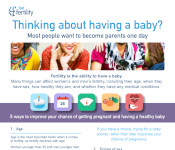-
Diabetes is a condition where the body is unable to keep blood sugar levels in the normal range. There are three types: type 1 diabetes, type 2 diabetes and gestational diabetes.
-
Type 1 diabetes
Type 1 diabetes occurs when the body’s immune system attacks the pancreas where insulin is produced. Insulin is the hormone that controls blood sugar levels, keeping them in the healthy range. In type 1 diabetes, the pancreas is unable to make enough insulin. Daily medication (insulin) is therefore needed to control blood sugar levels.
-
Type 2 diabetes
Type 2 diabetes is a progressive condition. It occurs over time, as the pancreas gradually becomes unable to produce enough insulin to keep blood sugar levels in the normal range, and the body becomes resistant to the effects of insulin. Together, this results in high blood sugar levels. Depending on the severity, type 2 diabetes can be managed with diet and exercise and medication.
-
Gestational diabetes
Gestational diabetes is high blood sugar that develops during pregnancy and usually disappears after giving birth. It can be managed with a healthy lifestyle (diet and exercise). Sometimes medication is also needed.
Myth busting
- MYTH
Diabetes only affects people who are overweight
FALSE
Diabetes can affect anyone, regardless of weight. Eating a healthy diet and regular exercise is important for everyone to help control blood sugar levels.
The facts
When diabetes is not well-controlled, it can affect the chance of having a baby. In women, diabetes can result in irregular or absent menstrual cycles, while in men it can cause problems getting and maintaining erections and lower levels of testosterone (the male hormone). It can also increase the risk of miscarriage and stillbirth, caesarean section and the baby needing intensive care after birth.
Well controlled blood sugar levels:
- can help menstrual cycles become more regular
- reduces the risk of erection problems
- increases men’s testosterone levels
- increases libido (sex drive)
- reduces the risk of miscarriage
- reduces the risk of having a very large baby, and the baby requiring intensive care after birth
- reduces the risk of congenital disorder (a health problem that starts at birth)
- reduces the risk of stillbirth and neonatal death
The good news
The good news is diabetes can be managed to control blood sugar levels. This involves regular monitoring of blood sugar levels, eating a healthy diet, regular physical activity, being in the healthy weight range, reducing stress and anxiety, and quitting smoking. Medication may also be needed. Your doctor can help you with the right information and accessing the support you need.
-
What you can do
Ideally, it is best to try for a baby when the diabetes is well-controlled and there are no other health problems. This will reduce diabetes-related risks during pregnancy.
Visit your doctor (GP) or diabetes specialist as soon as you start thinking about having a baby; around 3 to 6 months before you start trying. It is recommended that women with type 1 or type 2 diabetes start taking high dose folic acid (2.5-5mg daily) at least one month before pregnancy and throughout the first trimester.
If you do become pregnant, see your doctor for a review of your diabetes as soon as possible. Your doctor will discuss ways to manage your diabetes to keep blood sugar levels in the healthy range during your pregnancy. This may involve:
- monitoring your blood sugar levels regularly
- creating a healthy eating plan
- some regular physical activity
- being in the healthy weight range
- reducing any stress or anxiety
- quitting smoking.
These healthy steps to manage your diabetes may be new for you, and might take a while to get used to. Studies show that people who try to improve their lifestyle are much more likely to succeed if they do it with someone else. If you and your partner get healthy together you improve your chance of getting pregnant and having a healthy baby.
Your doctor will monitor your pregnancy and review your current medications to make sure they are safe to take while trying to get pregnant and during pregnancy.
-
Links
Visit the NDSS Pregnancy & Diabetes website for a complete set of resources to help you manage your diabetes and ensure you give your child the best start to life.
1. Having a healthy baby booklet- type 1 diabetes
2. Having a healthy baby booklet – type 2 diabetes
3. Gestational diabetes e-booklet
Visit the Australian Government’s Quit website for information, phone support, coaching and apps to help you quit smoking
Livelighter helps with healthy eating plans, delicious recipes and top tips for a healthier lifestyle
For more information about how to manage diabetes before and during pregnancy visit the National Diabetes Services Scheme (NDSS) Pregnancy & Diabetes website (for women) and Andrology Australia website (for men).
-
References
References
- ADDIN EN.REFLIST 1. Solomon CG, Hu FB, Dunaif A, Rich-Edwards J, Willett WC, Hunter DJ, et al. Long or highly irregular menstrual cycles as a marker for risk of type 2 diabetes mellitus. JAMA. 2001;286(19):2421-2426.
- Maresch CC, Stute DC, Alves MG, Oliveira PF, de Kretser DM, Linn T. Diabetes-induced hyperglycemia impairs male reproductive function: a systematic review. Hum Reprod Update. 2018;24(1):86-105.
- Duong V, Davis B, Falhammar H. Pregnancy and neonatal outcomes in Indigenous Australians with diabetes in pregnancy. World J Diabetes. 2015;6(6):880-888.
- Group HSCR, Metzger BE, Lowe LP, Dyer AR, Trimble ER, Chaovarindr U, et al. Hyperglycemia and adverse pregnancy outcomes. N Engl J Med. 2008;358(19):1991-2002.
- The Royal Australian College of General Practitioners. General practice management of type 2 diabetes: 2016–18. . East Melbourne, Vic RACGP,; 2016.



